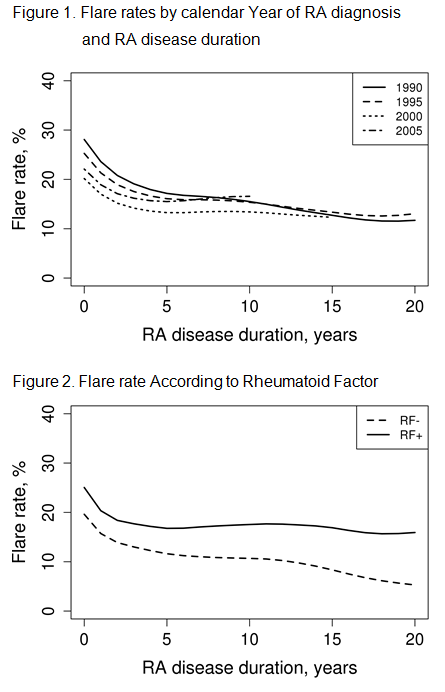Session Information
Date: Monday, November 14, 2016
Title: Rheumatoid Arthritis – Clinical Aspects - Poster II: Co-morbidities and Complications
Session Type: ACR Poster Session B
Session Time: 9:00AM-11:00AM
Background/Purpose: Flare or episodic worsening of disease activity is an important aspect of the disease experience for patients with rheumatoid arthritis (RA). Improving trends towards lower RA disease activity have been suggested in recent years. However, long-term data on flare rates in RA are lacking. This study aimed to assess trends in the occurrence of flares in RA over disease duration.
Methods: A population-based cohort of patients with RA (age≥18 years; 1987 ACR criteria met in 1988-2007), was used to perform this retrospective medical records review of each clinical visit to estimate flare status. RA flare was defined as any worsening of RA activity leading to initiation/change/increase of therapy (OMERACT 9). All subjects were followed until death, migration or July 1, 2012. Flare rates were calculated as the percentage of visits in flare. Binomial regression models with random effects to account for multiple visits per subject were used to assess the associations between patient characteristics and flare rate. Smoothing splines were used to allow for non-linear effects. Two way interactions between RA disease duration and other patient characteristics were examined.
Results: The study included 650 RA patients (mean age 55.8 years; 69% female) with mean follow up of 10.3 years. Flare status was collected for a total of 17,323 clinical visits. Patients were flaring in 2887 (17%) visits. Figure 1 shows trends in flare rates after RA onset by calendar year of RA diagnosis. There was a statistically significant decline in the RA flare rate across disease duration (p<0.001), predominantly in the first 5 years after diagnosis of RA. Patients diagnosed with RA in more recent years experienced fewer flares during the first few years of RA (p<0.001). Women tended to have marginally higher flare rates as compared to men, but this did not reach statistical significance (p=0.16). There were no differences between the sexes in trends of flare rates over time (interaction p=0.42). Flare rates were similar for all ages in the first few years after RA diagnosis, but in subsequent years patients diagnosed with RA at younger ages had higher flare rates than those diagnosed at older ages. Patients with positive rheumatoid factor (RF) had higher flare rates than negative RF (p<0.001), and flare rates declined more over disease duration in patients with negative RF than those with positive RF (interaction p=0.047; Figure 2).
Conclusion: Patients diagnosed more recently have lower rates of flares than those diagnosed in prior decades. Flare rates declined fastest in the first 5 years of disease and tended to be stable thereafter. These patterns likely reflect improved control of RA activity and possibly milder RA disease course in the recent years. However, flares continue to occur persistently at a constant rate after the five years of RA, reflecting the need for improved long term disease management.
To cite this abstract in AMA style:
Raheel S, Crowson CS, Matteson EL, Myasoedova E. Declining Flare Rates in the First Five Years of RA Disease, but Not after [abstract]. Arthritis Rheumatol. 2016; 68 (suppl 10). https://acrabstracts.org/abstract/declining-flare-rates-in-the-first-five-years-of-ra-disease-but-not-after/. Accessed .« Back to 2016 ACR/ARHP Annual Meeting
ACR Meeting Abstracts - https://acrabstracts.org/abstract/declining-flare-rates-in-the-first-five-years-of-ra-disease-but-not-after/

